Sep-23-04
 | | Honza Cervenka: Very poor performance of Marshall. Wolf beat him like a little child here. |
|
Nov-20-10
 | | profK: What was Marshall's brain doing...not playing chess for sure. |
|
May-29-15
 | | GrahamClayton: 16. ♘b1 was forced, giving the bishop an escape square to either e2 or f1. |
|
| Sep-07-19 | | whiteshark: The man who cried 'Wolf' |
|
Jul-03-20
 | | Honza Cervenka: <GrahamClayton: 16. ♘b1 was forced, giving the bishop an escape square to either e2 or f1.> It doesn't help at all. After 16.Nb1 black can simply take on b2 with decisive advantage, and even better can be 16...Ne4 17.c3 Nxg3 18.fxg3 e5 with overwhelming position. 15.h4 was a blunder and white should play 15.a3 to prevent 15...b4. |
|
Aug-11-24
 | | KEG: <Honza Cervenka> has aptly characterized this incredibly weak effort by Marshall. Playing over this game will cause every Marshall fan heartache. Marshall had gotten off to a strong start at this tournament. He had been in third place for most of the event, and despite his loss in Round 17 he entered Round 19 (with three rounds to go) in nominal fourth place (with Teichmann having two replays, he could have theoretically surpassed Marshall by winning the rest of his game). Indeed, had Marshall won his final three games, all other things being equal, he could have passed Pillsbury and Janowski and taken 2nd place (behind Maroczy). But starting with this game, Marshall lost all thee of his remaining games--to Wolf here and then to Janowski in Round 20 and to Pillsbury in Round 21. This left Marshall in 9th place and entirely out of the money. Wolf, by contrast, won this game and then beat Albin in the final round, and drew the rest of his games. This left him in a respectable tie for 5th place with Schlechter and Tarrasch. (Lofty company!) 1. d4 d4
2. Nc3

click for larger viewMarshall played this off-beat line in several of his games at the outset of his career. The move is of course playable, even though it blocks the White c-pawn. Given Marshall's prior experience with this variation, one might have expected he would have a more profound understanding of its secrets than he displayed in this game. 2... Nf6
3. Bg6
I prefer 3. Bf4 here, but both moves have been played in this position with some frequency. 3... c5
Looks best.
As the Tournament Book noted, if here 3...e6 then White can play 4. e4 with some (very small) advantage. 4. e3
4. BxN as recommended by the Tournament Book, is also OK. But the follow-up line proposed is too flawed to waste time discussing it. 4... Nc6
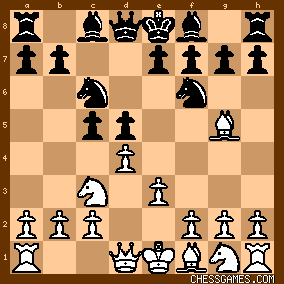
click for larger view5. dxc5
While not a blunder of any kind, this move looks awkward. Nakamura played it in a speed game in 2016, but that was probably an effort at surprise. I don't see the point with this move. 5... e6
6. Nf3
For some reason, the Tournament Book discusses the blunder 6. Na4? which, as it goes on to note, loses to 6...Qa5+ 7. c3 Ne4. If White were so worried about his c-pawn, he presumably would not have played 5. dxc5 6... Bxc5

click for larger view7. Bd3 a6
8. 0-0 0-0
9. e4
This must have been what Marshall was aiming for. But White is certainly not better at this point, leaving us to wonder about Marshall's opening strategy: 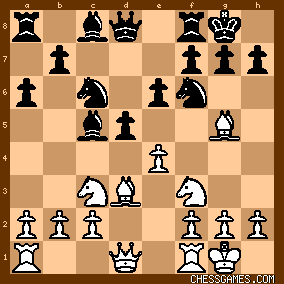
click for larger viewTo this point, at least, Marshall had not made any horrendous mistakes...just questionable strategy for playing White. But soon enough the blunders came, Marshall somehow seeming unsure of himself in the opening line he selected. |
|
| Aug-11-24 | | FM David H. Levin: <Aug-11-24 KEG: [...snip...] 3. Bg6>
It should read 3. Bg5.
In case it might be useful, here's what I do if I'm preparing a post that quotes a game score at this website. I "view" the "source" of the game's webpage in my browser, scroll down within the "source" to where the game score is given, mouse-copy the moves of interest, and paste those moves into the application I'm using to create/edit the material. This avoids my having to manually type any of the moves in the main sequence. |
|
| Aug-11-24 | | FM David H. Levin: <Aug-11-24 KEG:
9. e4
This must have been what Marshall was aiming for. But White is certainly not better at this point, leaving us to wonder about Marshall's opening strategy:> I'm not sure that I fully understand the implicit premise for the second sentence. Is it saying that the Veresov opening should give White an edge, that White was worse at this point, or something else? |
|
Aug-11-24
 | | KEG: <FM David H. Levin> Thanks for catching the typo. I wish my computer skills were not so feeble that I may not be able to avail myself of your suggestion. I will, however, show your post to my daughter (who is computer literate) who may be able to explain how to use your idea. My point about 9. e4 is based on a flaw that Wolf did not exploit. He should have responded 9...d4. My more general point is based on my bewilderment at Marshall's strategy. Players with White usually try to obtain at least a small edge from the opening. Since Marshall had experience with 2. Nc3, one might expect he was at least trying to get some advantage. Don't we all try that with White? He seems to have been pointing towards e4. Shouldn't he have satisfied himself that this would be advantageous for White and considered the consequences if Wolf--as he actually did--played a non-threatening 9th move? Even worse, when Wolf missed 9...d4, Marshall still did not display any understanding of the position as his subsequent play reveals. I will try to explain this in my next post on this game. |
|
| Aug-12-24 | | FM David H. Levin: <Aug-11-24 KEG: [...snip...] My more general point is based on my bewilderment at Marshall's strategy. Players with White usually try to obtain at least a small edge from the opening.> True, but if the theory of a given opening provides Black with a way of equalizing and (s)he finds it at the board, then I don't see how White can forcibly obtain an edge at that moment. (This isn't meant as a statement about whether White should have obtained the advantage in the opening of the present game.) <Since Marshall had experience with 2. Nc3, one might expect he was at least trying to get some advantage. Don't we all try that with White?> Sure, but if the Veresov is equal with best play and Wolf didn't make an inaccuracy, then I'd think it might be prudent (at least theoretically) for Marshall to fall back on trying to outplay the opponent in the middle game or endgame. <He seems to have been pointing towards e4. Shouldn't he have satisfied himself that this would be advantageous for White...> This seems to assume either that Black erred or that White is entitled to a theoretical edge in that opening. If neither is the case in this game (which I state as a hypothetical rather than an assertion), then it doesn't seem to me that Marshall's move 9. e4... should be criticized solely because it shouldn't have given him the advantage. |
|
Aug-12-24
 | | KEG: <FM David H. Levin>I am most definitely not criticizing 9. e4. It looks like best play to me. What I am trying to say, perhaps not very clearly, is that White should always seek opening lines that provide some edge. Marshall chose an unorthodox 2. Nc3 presumably because he had experience with the move. When I spring a surprise opening variation as White, it is because I am hoping to get at least some small edge. Otherwise, I could just play something like the Four Knights Opening. I was giving Marshall the benefit of the doubt in conjecturing that he thought he could obtain some advantage. The fact that the indicated 9. e4 gives White at best even chances suggests that Marshall's opening strategy was flawed. It is not as if Wolf sprang any surprise of his own against 2. Nc3. In fact, he missed his strongest replay to 9. e4 (9...d4) and even then Marshall had little or nothing to show for his opening selection. Had Wolf been a weak player, Marshall might perhaps have just sought equality and then hope to outplay him. But Wolf was about at Marshall's level at this point in their respective careers. In sum, I am bewildered by Marshall's opening here. All of this, however, is perhaps besides the point given that Marshall played like a fish beginning a few moves after 9. e4. If I had only this game to go on, my regard for Marshall would not be very high. |
|
| Aug-12-24 | | FM David H. Levin: <KEG: <FM David H. Levin>I am most definitely not criticizing 9. e4. It looks like best play to me. What I am trying to say, perhaps not very clearly, is that White should always seek opening lines that provide some edge. Marshall chose an unorthodox 2. Nc3 presumably because he had experience with the move. When I spring a surprise opening variation as White, it is because I am hoping to get at least some small edge.> Ah, I think I understand now. Thanks for elaborating. According to Monte Carlo (1902)/Frank Marshall, Marshall's nine previous games with White in this tournament included seven QGDs (plus one Dutch and one French). So, perhaps Marshall had expected Wolf to be well-prepared for a Queen's Gambit. If so, the former's "surprise" 2. Nc3 didn't pan out, although I'm not sure it was that bad an idea. As Maxwell Smart often said, "We know that now, Chief. We didn't know that then." 8^) |
|
Aug-13-24
 | | KEG: Post II
9... Be7
Not any sort of blunder, but far less enterprising than 9...d4. Even 9...h6 would have been stronger than the text, which left the position as: 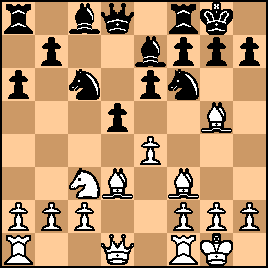
click for larger view10. e5
"?"--(Tournament Book)
The Tournament Book claimed that 10. BxN BxB 11. exd5 would have been "better," but it derives an advantage for White through some questionable analysis: 11...exd5 12. Nxd5 Bxb2 13. Rb1. But in this line Black does better with 11...BxN instead. Actually, best for White here would have been 10. exd5 exd5 11. BxN BxB 12. Nxd5 Bxb2 13. Rb1 arriving at the position at the end of the Tournament Book's proposed line but with more sensible play. A further problem with assigning a "?" to 10. e5 is that White is not in any major trouble after the move. 10... Nd7
This left:

click for larger viewFrom here, however, things got weird.
11. Bf4?
This left Marshall open to trouble. On this one I agree with the Tournament Book which gave 11. BxB QxB 12. Re1. But I do disagree with the statement that this would have been a "little better.''In fact, the proposed line is a major improvement on 11. Bf4. But Wolf wimped out with: 11... f6?
Creating a weakness with no payback. Wolf could have seized a major initiative with 11...g5!, especially if Marshall, instead of responding 12. Bg3 played 12. Nxg5 BxB 13. Qg4 h6 14. h4 Ndxe5 15. Qg3 NxB 16. cxN e5 17. Bd2 f6 18. f4 exf4 19. Bxf4 Rf7 20. hxB fxf5 21. Rf2 leaving White the better chances because of the weak Black d-pawn despite the potentially equalizing effect of the Bishops of opposite colors. 12. exf6 Bxf6
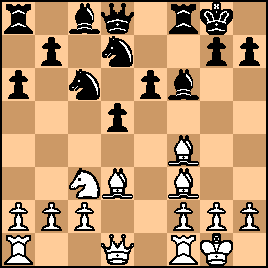
click for larger viewNow Marshall could obtain approximate equality with 13. Bd6, but instead played the weaker: 13. Bg3 Ne5
14. Re1 b4

click for larger viewThe game was still very much in the balance, but now Marshall--for whatever reason--collapsed: 15. h4?
"?"--(Tournament Book)
While the text was indeed a wretched move (<Honza Cervenka> correctly calls it a "blunder") the alternative suggested by the Tournament Book: 15. Ne5? was almost as bad: 15...NxN 16. BxN and now not 16...BxB as given in the Tournament Book but 16....b4 <Honza Cervenka> on this site has provided the key to the position. Marshall should have prevented ...b4 by Black by the simple 15. a3! After the text, the game fell apart for Marshall.: 15... b4!
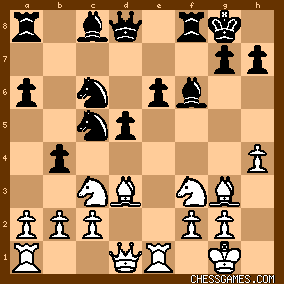
click for larger viewThe game was probably now already theoretically lost for White (once again, as pointed out by <Honza Cervenka>), but here Marshall blundered once again losing a piece immediately and allowing Wolf to have a short day at the office. The balance of the game, as I will discuss in my next post, is painful for admirers of Marshall to watch. |
|
| Aug-13-24 | | FM David H. Levin: <KEG: Post II
10. e5
"?"--(Tournament Book)
The Tournament Book claimed that <10. BxN BxB 11. exd5> would have been "better," but it derives an advantage for White through some questionable analysis: 11...exd5 12. Nxd5 Bxb2 13. Rb1. But in this line Black does better with <11...BxN> instead.> (Emphasis added.)After 10.Bxf6 Bxf6 11.exd5 Bxc3 12.dxc6,
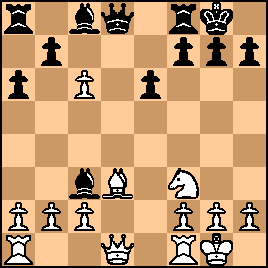
click for larger viewWhite's b-pawn seems poisoned owing to the veiled threat against the b7-square: 12...Bxb2 13.Rb1 <If now 13...Qb6, then 14.Ne5, threatening 15.Nc4 and denying Black the time to open the b-file and play ...Rb8 to further protect the b2-bishop.> 13...Qf6 14.c3 Qxc3 15.Qc2. It seems therefore that Black must give up a pawn after 12.dxc6, but I'm not sure Black has enough compensation after 12...Bf6 13.cxb7 Bxb7 14.c3 e5 15.Re1, for example. (I realize that this is entirely avoided if White plays your suggested 10.exd5
rather than 10.Bxf6.) |
|
| Aug-13-24 | | FM David H. Levin: <KEG: Post II
11... f6?
Creating a weakness with no payback. Wolf could have seized a major initiative with 11...g5!, especially if Marshall, instead of responding 12. Bg3 played 12. Nxg5 BxB 13. Qg4 h6 14. h4 Ndxe5 15. Qg3 NxB 16. cxN e5 17. Bd2 f6 18. f4 exf4 19. Bxf4 Rf7 20. hxB fxf5 21. Rf2 leaving White the better chances because of the weak Black d-pawn despite the potentially equalizing effect of the Bishops of opposite colors.> I'm confused as to why 11...g5 receives an exclamation point even though the resulting position is evaluated as better for White, yet 11...f6 receives a question mark even though it allowed White a chance only for "approximate equality" at move 13. |
|
Aug-14-24
 | | KEG: <FM David H. Levin> Following up on your line, after 10. BxN BxB 11. exd5 BxN 12. dxN, you are surely correct that Black must settle for 12...Bf6, and White does indeed come out a pawn ahead with 13. cxb7 Bxb7. But I disagree about whether Black has descent compensation for the lost pawn. If White now plays your suggested 14. c3 (14. Rb1 looks a tad better, but Black is still reasonably placed) Black would indeed be in a tough situation if he played your suggested 14...e5. However, Black looks just fine after 14...Rb8 15. Rb1 Qc7. White is still up a pawn, but Black has the two Bishops and some open lines for his Rooks and his Queen. The computers rate the game now as equal, but I would prefer to be playing Black. |
|
Aug-14-24
 | | KEG: <FM David H. Levin> I'm not sure what software your are using. Both Fritz and Stockfish rate Black as better after 11...g5! Stockfish, however, thinks Black is better still with 11...f6 (Fritz strongly disagrees, as do I). But you are quite right to be confused by my post. For one thing, in the line I gave after 12. Nxg5, Black's next move is 12...BxN, not 12...BxB. More seriously, at the end of the line I gave (ending with 21. Rf2) my comment that White now "had the better chances" was nutso. Black is up a pawn. My comment about the weaknesses in Black's position mean that, despite the extra pawn, Black remains only marginally better...but clearly better in my opinion than after 11...f6 (Stockfish's evaluation notwithstanding). As always, thank you for your close reading and for keeping me honest. |
|
| Aug-14-24 | | FM David H. Levin: <KEG: <FM David H. Levin> I'm not sure what software your are using. Both Fritz and Stockfish rate Black as better after 11...g5!> I didn't evaluate 11...g5; I was simply quoting your statement that White would stand better after move 21 in your analysis. Given your subsequent clarification that the statement that White stood better in that variation was unintentional, the inconsistency I was drawing attention to is resolved. |
|
Aug-15-24
 | | KEG: Post III
16. Ne2?
As <Honza Cervenka> has pointed out, Marshall was likely lost even before this silly mistake. 16. Nb1 does indeed look "forced" (to quote <GrahamClayton>, and the text leads to an immediate loss of a piece (or worse). But, and again to quote <Honza Cervenka>, Black then can win either with the brutal 16...Bxb2 or with the prettier 16...Ne4. After the text, things got truly ugly:
16... e5
"!"--(Tournament Book)
"The winning move. White cannot now prevent the loss of material." (Tournament Book) 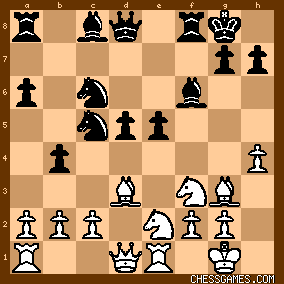
click for larger view17...e4 is now coming, and there was nothing Marshall could do about it. He might have called it a day here, but chose to suffer on for another eight painful moves: 17. Ng5
Utterly hopeless, but I see nothing better.
17... e4
Ouch!

click for larger view18. Bd6 QxB
18...NxB was perhaps even simpler, but it hardly mattered at this point. 19. Bc4
This was Marshall's little trick, since the Black d-pawn is pinned. But there was a brutal refutation: 19... Rd8
20. Bb3 h6
Even quicker than 20...Bxb2. Now Marshall went into full desperado mode: 21. Nxe4?! Nxe4

click for larger viewMarshall was now TWO pieces down and still facing a nasty attack. From this point, I have no idea what Marshall was hoping for (except perhaps not to lose TOO short a game). 22. Nd4 NxN
23. RxN NxB
Marshall was now running out of pieces to lose.
24. axN dxR

click for larger view0-1
Now down two Bishops and a Rook with no compensation whatsoever. So he finally decided to call it a [very unpleasant for him] day. |
|
|
|
|





